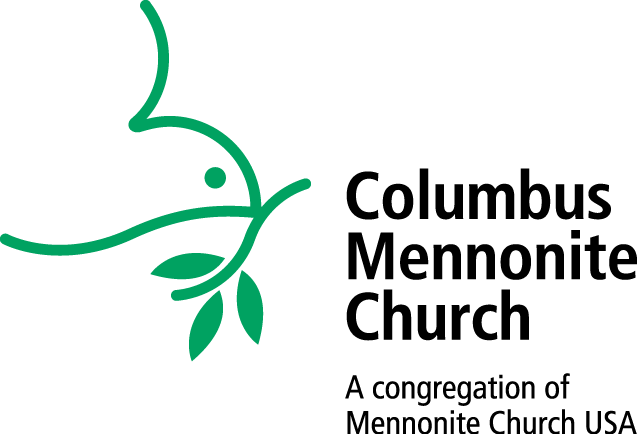Joint worship service with North Broadway United Methodist Church| 28 August 2016
While our sanctuary undergoes renovations, we held a joint worship service with our neighbors at North Broadway United Methodist Church. For the sermon their pastor and I each talked about our own faith traditions and how our congregations are living that out. Below are my portions of the sermon.
Text: Matthew 5:1-12
You all have been such good neighbors to us this summer. We have held both a regional conference and three Sundays of worship in your fellowship hall. And it feels very fitting that we now get to worship together, so many thanks for that.
In my experience, people tend to have three main frames of reference for Mennonites.
The first, and probably most common preconception, is that Mennonites are kind of like the Amish. We are Amish-lite. Same great taste, but less filled with rules and regulations about dress and technology. And this is kind of historically accurate. Mennonites and Amish do share a spiritual ancestry. The 16th century Anabaptists emphasized that baptism and the Christian life were to be arrived at through a conscious adult decision. Anabaptist means “re-baptizers.” At the beginning of the 18th century, Jacob Amman (Amish) believed his sisters and brothers in this stream of the church were becoming too lax in their enforcement of discipline, and that people who weren’t willing to be baptized as adults should not be considered “saved.” A new fellowship formed around his leadership, and the Amish, and the Mennonites parted ways…but we remain cousins.
A second association some people have with Mennonites is what we do. Mennonites are active in disaster relief in the US and Canada, our Mennonite Central Committee has people serving around the world in community development and peacemaking efforts. Mennonites were involved in helping initiate the current Fair Trade movement. Some of you Methodists know us Columbus Mennonites through…
“She stood up straight” | 21 August 2016
Text: Luke 13:10-17
The great 16th century reformer Martin Luther characterized the human condition with the Latin phrase “homo incurvatus in se.” I never studied Latin, but this is a good one for beginners. It sounds a lot like its English equivalent. Homo – Human. incurvatus – curved in. in se – on itself. This is the predicament of our species, Luther taught, our sinful state. Humanity curved in on itself.
This can be pictured fairly easily. It’s visual. It is bodily. Rather than having one’s head up, eyes looking out, ears attentive, the body curves in on itself. Incurvatus. And we are stuck. We can’t see beyond ourselves. We can’t really reach out beyond ourselves. We are curved in on ourselves.
And if this is the broken condition, then salvation looks like this: Having one’s back straightened, one’s shoulders lifted, one’s head raised, eyes now alert, arms open. Curved in à salvation.
I’ve been assuming these two positions at random times the last few days, partly to feel the difference between them, and partly because I overworked my back one day during the stay-cation portion of our vacation and am still feeling it. The hidden cost of do it yourself house projects.
I once heard someone say that you know you’re getting older when you bend over to pick something up and you think, Now what else can I do while I’m down here. I’m not that bad off – yet.
It just so happens that this week’s gospel lectionary has to do with incurvatus and standing up straight. Jesus is teaching in the synagogue, the final time he will do this in Luke. It’s the Sabbath, the day of rest. And there was a woman there. A woman whose name we never learn, identified only by her disability. As Luke tells it, she had…
Home Again | 14 August, 2016
In my experience, people leave behind the strangest things when they move. When I moved into my previous apartment, I found in the back of one of the kitchen cupboards a triangle shaped plate made especially for pizza. At first I got excited and thought, “It’s like the previous tenant knew me so well.” Then, after thinking about it, I realized the previous tenant didn’t know me at all because, for one, I prefer square pizza, and secondly, let’s be honest, who has time for just one piece of pizza on a plate. No wonder that plate got left behind.
In other places, I have found a screwdriver, a doormat, a sock, and the lid to a Tupperware container. I can only imagine what I, myself, may have left behind.
Now I don’t intend to over romanticize these objects as if there was some grand epiphany or life-changing moment that must have led someone to cast off their pizza shaped plate in some grand gesture of transformation. Let’s be clear, everything I’ve inherited in my various moves has been junk that was forgotten.
But as someone who has moved a couple times in the last few years, and most recently in the last two weeks, I often find myself thinking about how moves in my life have coincided with major life changes: starting school, changing jobs, preparing to get married. And thus, from apartment to apartment, things both material and symbolic have been left behind or discarded to make room for the newness that comes with building a life that continues to ebb and flow.
Times of actual physical moves, reconstruction, rebuilding, and change are often good times to take stock of what we must leave behind and what we must take with us. As we find ourselves in this strange setting this morning,…
“Neither shalt thou stand idly by” |24 July 2016
Text: Luke 10:25:37
A woman was walking out from her house to her car when suddenly two men snatched her purse, pushed her down, and fled the scene. Several of her neighbors heard the commotion, opened their curtains, but quickly closed them again. Another saw what happened and called 911. Several others went out to the woman, helped her up, and stayed with her until the police and medics arrived.
Now the two men who mugged her were convicted felons. They’d recently received early release from prison for good behavior. They had every intention of finding a job and leading productive lives, but every place they applied rejected their application because of their status as felons. Like other felons, they were barred from receiving federal cash assistance, food stamps, and other benefits. They were also ineligible to live in public housing. Without any source of income and without shelter, they soon resorted to petty crime to supply their needs.
They were never caught for stealing the woman’s purse. One day, soon afterwards, they saw a news feature about a local organization with an internship program to help the formerly incarcerated get job placements. Rather than using the word “felon,” or “ex-felon,” this organization referred to people like them as “returning citizens.” The men visited the organization, were accepted as a part of the program, and after excelling through the six month internship, began full time jobs. Once they were settled in an apartment with some extra cash, one of them had an idea that the other quickly agreed to, even though it involved breaking the law.
Late at night they returned to the home of the woman they had mugged. They ran up to the mailbox, put an envelope inside (which is illegal), and drove off down the street before anyone saw them. …
“Half dead” | 17 July 2016
Text: Luke 10:25-37
Toward the end of last year I saw a political cartoon that used the image printed on the bulletin cover. This was at the peak of the debate about accepting Syrian refugees into the US. A little over half of the nation’s governors had declared that their states were off limits.
In the cartoon, text was superimposed at the bottom of this image, which said: “Bible school primer for governors during refugee crisis.” There were also two dark arrows pointing at the travelers exiting the scene, with the words: “These guys are not the heroes of the story.” Another arrow pointed to the one who had stopped to give assistance, with the text: “This guy is the hero of the story (you want to be this guy).”
Aside from the political and moral message, a couple things stood out to me with the cartoon.
One was how deeply this parable of the Good Samaritan has made its way into our cultural lexicon. Of all the stories and parables in the Bible, this is one of the most recognizable. The political cartoon doesn’t work – or at least not near as well – unless this is the case. The unwritten assumption is that everybody already knows who the hero is in this story.
The other thing that stood out to me is how much this parable has come to be about the moral agency of these three actors – the priest, the Levite, and the Samaritan. One of the brilliant features of the parable is all the different questions it invites us to ask about why these characters do what they do. Or don’t do what they don’t do.
The priest and the Levite are both religious figures. Some commentators have wondered if they were concerned with purity laws, should the half dead…

